
Credits: www.poemhunter.com
Recent Ridley Scott’s movie about Napoleon has reminded me of the charming engagement ring given by Napoleon to his beloved Joséphine de Beauharnais. I admired it in numerous photos about ten years ago and at that time I decided I should have analyzed it one day.
The famous director has rightly pointed out that around 10,400 books have been published about Napoleon, but an infinitely smaller number were reserved for the only woman he truly loved. So, I thought the time had come to delve deeper into this topic and dedicate an article to the ring that started this incredible love.
First of all, who was Joséphine de Beauharnais and how did she meet Napoleon?
Joséphine was born in 1763 on the Caribbean island of Martinique. She might be considered as an outsider, being her native land so far, and perhaps this feeling might have been a common point with Napoleon. In fact he was from Corsica and, as a boy, he was often teased for his Corsican accent during his school years of in France.
Marie-Josèphe-Rose Tascher de La Pagerie – this was her full name – was the first of three daughters and her family lived in a building owned by her father Gaspard. The latter, an alcoholic and gambler, owned 300 slaves, whom he employed on his sugar cane plantation.

Childhood home of Empress Joséhine at the Museum de la Pagerie – Credits: www.rentiles.fr/blog-voyage/musee-de-la-pagerie

Credits: @CMT-R. Haughton, childhood home of Empress Joséphine at the Musée de la Pagerie / www.france.fr
Her family lived in prosperity, but in 1766, the plantation was destroyed by a hurricane and issue required a quick and strategic solution: the arranged marriage of one of the daughters. The choice fell on the eldest, Catherine, who however died in 1777, clearing the way for Marie Josèphe.
The young girl, nicknamed Yeyette, at the age of 16 left for France with her father and got married to the wealthy French viscount Alexandre de Beauharnais, three years her senior. The couple was not linked by any affection, indeed it seems that he hated her and accused her of adultery. The birth of their two children Hortense and Eugène did not improved their relationship. Marie-Josèphe was just about 20 years old when her husband decided to leave her. She returned to Martinique, where she remained for two years, while he participated in the States General as a noble deputy. The revolutionary movement, however, was swept away by the period of Terror, which had led to the execution of King Louis XVI and Queen Marie Antoinette and which was still seeking aristocrats and landowners.

Alexandre de Beauharnais, unknown painter – Credits: www. dailymail.co.uk
Alexandre was arrested on charges of being a traitor and with him also Marie-Josèphe, who in the meantime had returned to France as his wife. In the prisons of Les Carmes, Marie-Josèphe lived a nightmare: Alexandre was victim of the guillotine and she knew she was going to be the next.
However, luck turned on her side: one day before his execution, Robespierre was deposed and the new officials decided to stop the executions. Saved by the skin of her teeth, Marie-Josèphe obtained her husband’s lands and possessions, but she left prison marked in body and soul: her young beauty had faded, her teeth were ruined and above all she could no longer have children. She was shocked by that experience and promised herself to never find herself in a dangerous situation again.
She became friends with a former prisoner, Thérésa Tallien, who later married a well-known politician of the time. The two women jumped into a whirlwind of parties and became local celebrities, so much so that they were nicknamed “Les Marveilleuses”.
At that time, Marie-Josèphe’s attention was caught by the rich and powerful Paul Barras, who effectively ruled France. Seducing him had been easy for her. He gave her a splendid house and all his devotion. But when in 1795, Marie-Josèphe realized that Barras was getting bored of her, she had to look around: she had turned 32 and needed to secure her future, possibly with a good marriage. The opportunity came during a dinner, when Barras proposed her to sit next to a young general who was having an extraordinary career. Not particularly attractive, awkward and inexperienced with women, that young general called Napoleon Bonaparte could not believe that the beautiful and charming Madame de Beauharnais was showing interest in his military exploits. He was struck by the familiarity she showed with the most influential personalities in Paris and wanted to understand how she had succeeded in this endeavour, given her origins were far from high society. That fateful evening Napoleon was overwhelmed by the “belle créole” hurricane.

Napoleone Bonaparte aged 23, lieutenant-colonel of a battalion of Corsican republican volunteers, portait by Henry Felix Emmanuel Philippoteaux – Credits: www.thevintagenews.com
He courted her insistently and renamed her Joséphine – as a contraction of her long name. She, despite not being particularly involved, agreed to the wedding.
Both his family and society were quite scandalized by Madame de Beauharnais’s choice to marry Napoleon. After all, at the time he was a soldier with no money and no important connections, but she was right: within ten years of their marriage, Napoleon managed to depose Barras, became consul and finally, in 1804, proclaimed himself Emperor of France. Napoleon was madly in love with Joséphine, so neither his family opposition nor the age gap could stop him.

Napoleon and Joséphine, unknown author
They got engaged on February 24, 1796 and married on March 9 of the same year. Two days later Napoleon left Paris to invade Italy, while she remained in Paris frequenting the high society soirées. He wrote her romantic and passionate letters, which she did not reciprocate, causing tension and jealousy in her husband. In fact, she was unfaithful to him and Napoleon was no different, even having an illegitimate child with one of his mistresses.
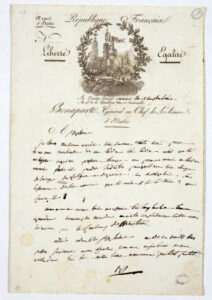
Letter from Napoleon to Joséphine – Credits: Archives Nationales-ae-ii-3128 no date – www.thevintagenews.com
Despite this, they did not break up and Joséphine always offered her decisive support for her husband’s career and political rise: she built public relations, earning trust from many people and settling potential disagreements. Her public role was that of the beautiful wife, covered in jewels, proof of her husband’s power, but in reality she was very skilled in public relations. The “decorative” image hid an intelligent and ambitious woman.
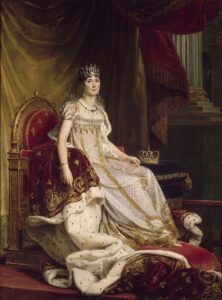
Portrait of Joséphine de Beauharnais by Francois Gérard (1807 circa), foto Public domain – Credits www.storicang.it
In 1799 Napoleon was appointed first consul and finally, on 2 December 1804, in the cathedral of Notre-Dame he was proclaimed Emperor of the French. During that same ceremony, Napoleon placed the crown on the head of Joséphine, who in turn became Empress of the French.

The Coronation of Napoleon by Jacques-Louis David (1804) – Credits: en.wikipedia.org
Their mutual infidelities were not the only issue which cause the end of their marriage. The political pressure they suffered to guarantee descendants for Napoleon played a huge role. Despite numerous medical visits, Joséphine was unable to conceive an heir, perhaps due to the terrible period she spent in prison. Her sterility became a state matter and divorce appeared as the only solution. In 1809, during a public ceremony in les Tuileries, Joséphine agreed to the «dissolution of a marriage which was now an obstacle to the good of France» and Napoleon formally announced the separation, agreeing to sacrifice the «sweetest affection of his heart» for the interest of the people.
During the rite of separation, both read mutual declarations of devotion.
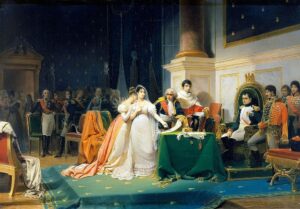
The divorce of Empress Joséphine 15 december 1809 by Henri-Frederic Schopin – Credits: en-wikipedia.org
Joséphine retired to the beautiful castle of Malmaison, a few kilometers from Versailles, while he married the young Marie Louise of Austria, commenting sadly: “I married a womb.” The young wife completed her duty and in 1811 she gave him the much desired legitimate successor.

Marie Louise and the King of Rome by Francois Gérard – Credits: www.bridgemanart.com / www. dailymail.co.uk
After leaving Paris, Joséphine dedicated herself to gardening and was always surrounded by friends and important people who paid visits to her.

Castle of Malmaison by Pedro Faber – Credits: en-wikipedia.org

Joséphine de Beauharnais at the Malmaison castle (1801) by Francois Gérard – Credits: en-wikipedia.org
In 1812, Napoleon started the unsuccessful Russian militar campaign and two years later he was captured and exiled to the Island of Elba. When Josephine’s death was communicated to him in 1814, probably caused by pneumonia, he locked himself in his room for two days and did not want to see anyone.
Despite the divorce, a strong feeling had united them throughout their lives, so much so that according to legend, on his deathbed on the island of St. Helena, Napoleon took his last breath by saying: “France. The army. Chief of the army. Josephine.”

Portrait of Joséphine later in life by Andrea Appiani – Credits: en-wikipedia.org
The love story between Napoleon and Joséphine marked an era, as much as the ring that crowned their engagement. From this jewel it emerges that Napoleon, as well as a leader and a fighter, was also a romantic man. Under the severe uniform, beat a heart so passionate that Joséphine declared: “He doesn’t love me, he adores me. I think he’ll go crazy.”
The ring was purchased when Napoleon was in financial straits and had not yet reached glory and the heights of politics. The jewel is composed of a diamond and a blue sapphire, both weighing approximately 1 ct, pear shaped cut and placed side by side. The gems are bezel-setting on a yellow gold circle, in a “toi et moi” style.
I got the idea that Napoleon was not only madly attracted to Joséphine – this is well known – but also that he held his wife’s intelligence, determination and perspicacy in high esteem. Without these talents, his personal climb to success perhaps wouldn’t have been so feasible and quick. He was a rough man, sometimes aggressive and certainly egocentric, however he was able to recognize excellence in Joséphine: two close gems, of equal carat. Even though he was aware of the differences between their characters, it seems clear to me that he considered her the other indispensable half of his world.
Precisely due to the simple design and the affinity symbolically expressed in such a clear way, I must admit that I find this jewel very touching.


Credits: something aboutrocks.com Credits: www.voltairediamonds.com


Credits: wardrobetrendsfashion.com Credits: www.truefacet.com
Joséphine gave her ring to her daughter Hortense, who became Queen of Holland and who in turn passed it to her son Napoleon III and her daughter-in-law, Empress Eugenie, whose descendants kept it until 2013.
In fact, on 24 April 2013 the Osenat auction house (whose offices are in Fontainebleau, outside Paris) put the famous ring up for auction, starting from an initial cost of 10,000 – 15,000 euros. The reason for this modest starting point is that Osenat chose to evaluate the jewel on the basis of the material and design only, intentionally excluding the imperial origin of the jewel. Jean-Christophe Chataignier, head of the historical objects department at the Osenat auction house, said: “At that time, Napoleon had little money and the ring is very ordinary.” The sale then concluded at the extraordinary price of 730,000 euros! The lucky buyer remained anonymous, of course.
The date chosen for the auction does not seem entirely fortuitous since 2013 was the 250th anniversary of Joséphine’s birth, which they wanted to honor this way.
The “toi et moi” style of Joséphine’s ring is popular today more than ever.
In past decades, Jackie Kennedy and Queen Margrethe II of Denmark had already brushed up this style, but in 2018 the super top Emily Ratajkovski, with her then husband Sebastian Bear-McClard and the designer Alison Chemla, designed her engagement ring. The jewel was composed of a 2ct princess cut diamond and a 3ct pear cut diamond, in a yellow gold prong setting.
After her, Ariana Grande, Kylie Jenner and Megan Fox also made us dream, decreeing the great return of this style. Look at the gallery below:

Queen Margrethe II of Denmark – Credits: @AP / www. dailymail.co.uk

Jacqueline Kennedy – Credits: www.jfico.com
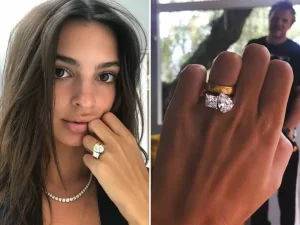
Emily Ratajkovski – Credits: @emrata Instagram / www.theknot.com

Ariana Grande – Credits: @arianagrande Instagram / www.brilliantearth.com
d
Kylie Jenner – Credits: @kyliejenner Instagram / www.brilliantearth.com
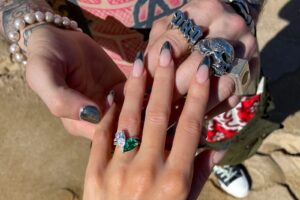
Megan Fox – Credits: www.katerinaperez.com
In addition to the famous engagement ring, in the same year Napoleon gave many other jewels to his Joséphine, among which there is a gold and enamel ring, bearing his initials “NB” and the inscription “sincere love”. This ring became part of the personal collection of Empress Eugénie, wife of Napoleon III, who then gave it to her doctor, Dr. A. Hugenschmidt (who was probably an illegitimate son of Napoleon III himself). In 1930 Dr. Hugenschmidt donated the ring to the Louvre, from where it later became part of the collection of the Malmaison museum.

Credits: www.napoleon.org-en-magazine-napoleonic-pleasures
The real wedding ring (which according to some would bear an inscription with the motto “au destin”) was instead given in 1814 by Napoleon to Hortense, Joséphine’s daughter, who in turn gave it to her son, Napoleon III. The jewel was last sighted on 10 January 1873 on the middle finger of the mortal remains of Napoleon III and is located in the crypt of Farnborough Abbey in Kent.
Prior to finishing this long article about Joséphine’s extraordinary life, I would like to recall her passion for botany and for rose gardens in particular. In her castle at Malmaison, Joséphine had a lush garden in which she collected rare plants from all over the world. She particularly loved his 250 species of roses, which she even had painted by Pierre Joseph Redouté. The painter illustrated them and published them in 120 tables, so that today we can admire all the beauty of these wonderful flowers and remember the enchanting Joséphine, Empress of the French.

Souvenir of Malmaison – Credits: en-wikipedia.org
Sources
Professor Kate Williams, “Josephine: Desire, Ambition, Napoleon”, published by Hutchinson. Arrow, 2014
www.storicang.it
www.dailymail.co.uk
www.forbes.com
www.thecourtjeweller.com
www.napoleon.org
jewelboxofmorganhill.com
www.marinaminelli.it/2018/12/17/malmaison-il-regno-di-josephine/
jewelryconnoisseur.net
dsfantiquejewelry.com
www.truefacet.com
www.langerman-diamonds.com
rhstories.com
napoleoneeilsuotempo.wordpress.com
somethingaboutrocks.com


